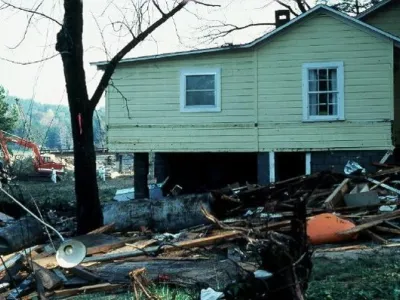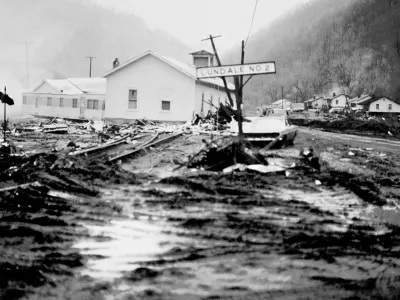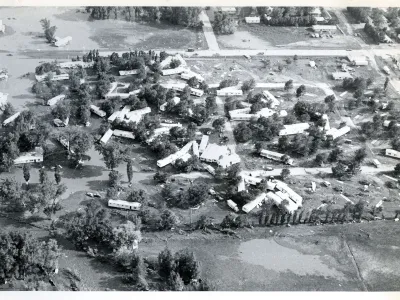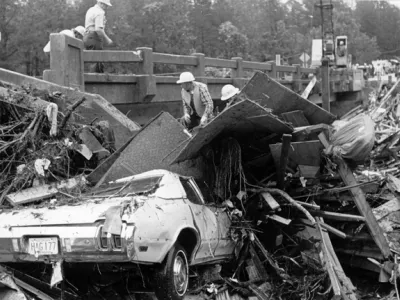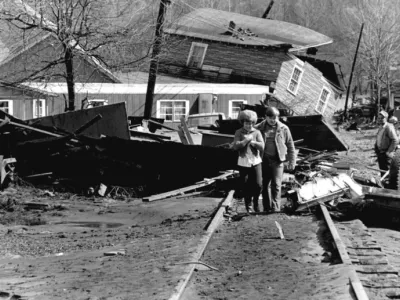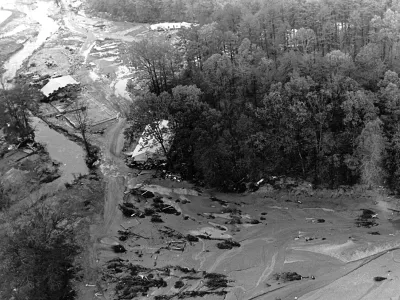On this page:
- Understanding Dam Failures
- The Causes of Dam Failures
- Learning From the Past: A Snapshot of Historic U.S. Dam Failures
- ASDSO Resources
Understanding Dam Failures
Hundreds of dam failures have occurred throughout U.S. history. These failures have caused immense property and environmental damages and have taken thousands of lives. As the nation’s dams age and population increases, the potential for deadly dam failures grows.
No one knows precisely how many dam failures have occurred in the U.S., but they have been documented in every state. From January 2005 through June 2013, state dam safety programs reported 173 dam failures and 587 "incidents" - episodes that, without intervention, would likely have resulted in dam failure.
The following is an excerpt from the American Society of Civil Engineers' 2017 Infrastructure Report Card detailing the importance of public safety and proper maintenance:
"In order to improve public safety and resilience, the risk and consequences of dam failure must be lowered. Progress requires better planning for mitigating the effects of failures; increased regulatory oversight of the safety of dams; improving coordination and communication across governing agencies; and the development of tools, training, and technology. Dam failures not only risk public safety, they also can cost our economy millions of dollars in damages. Failure is not just limited to damage to the dam itself. It can result in the impairment of many other infrastructure systems, such as roads, bridges, and water systems. When a dam fails, resources must be devoted to the prevention and treatment of public health risks as well as the resulting structural consequences."
The Causes of Dam Failure
Dam Failures Are Most Likely to Happen For One of Five Reasons:
1. Overtopping caused by water spilling over the top of a dam. Overtopping of a dam is often a precursor of dam failure. National statistics show that overtopping due to inadequate spillway design, debris blockage of spillways, or settlement of the dam crest account for approximately 34% of all U.S. dam failures.
Click Here for Video Example [YouTube]
2. Foundation Defects, including settlement and slope instability, cause about 30% of all dam failures.
Click Here for Video Example [YouTube]
3. Cracking caused by movements like the natural settling of a dam.
4. Inadequate maintenance and upkeep.
Click Here for Video Example [YouTube]
5. Piping is when seepage through a dam is not properly filtered and soil particles continue to progress and form sink holes in the dam. [See an animation of a piping failure.] Another 20% of U.S. dam failures have been caused by piping (internal erosion caused by seepage). Seepage often occurs around hydraulic structures, such as pipes and spillways; through animal burrows; around roots of woody vegetation; and through cracks in dams, dam appurtenances, and dam foundations.
Click Here for Video Example [YouTube]
Causes of Dam Failure Incidents, 2010-2019**


** From the ASDSO Dam Incident Database, dam failure incidents for the years 2010 through 2019. Incident data mostly obtained from the state dam safety programs and/or media reports. The incident data is not inclusive of all dam safety incidents.
Learning From The Past: A Snapshot of Historic U.S. Dam Failures
Before Dam Safety Laws
At 7:20 a.m. on May 16, 1874, the 43-foot-high Mill River Dam above Williamsburg, Massachusetts failed, killing 138 people, including 43 children under the age of ten. This failure was the worst in U.S. history, up to that time.
Fifteen years later, on May 31, 1889, this tragedy was replayed on a larger scale in Pennsylvania. Over 2,200 people - more than one in five residents of Johnstown - perished in the flood caused by the failure of South Fork Dam, nine miles upstream.
Many more failures - in Arizona, Tennessee, Oregon, North Carolina, Texas, Virginia, West Virginia, and elsewhere across the U.S. - occurred around the turn of the century, and some early state dam safety legislation was passed.
The failure of St. Francis Dam, in March 1928, was a landmark event in the history of state dam safety legislation, spurring legislation not only in California, but in neighboring states as well. However, most states had no substantive dam safety laws prior to a series of dam failures and incidents that occurred in the 1970s.
Historic U.S. Dam Failures of the 1970's
February 26, 1972 - Buffalo Creek Valley, West Virginia
The failure of a coal-waste impoundment at the valley’s head took 125 lives, and caused more than $400 million in damages, including the destruction of over 500 homes.
June 9, 1972 – Rapid City, South Dakota
The Canyon Lake Dam failure took an undetermined number of lives (estimates range from 33 to 237). Damages, including the destruction of 1,335 homes, totaled more than $60 million.
June 5, 1976 – Teton, Idaho
Eleven people perished when Teton Dam failed. The failure caused an unprecedented amount of property damage totaling more than $1 billion.
July 19-20, 1977 – Laurel Run, Pennsylvania
Laurel Run Dam failed, killing over 40 people and causing $5.3 million in damages.
November 6, 1977 – Toccoa Falls, Georgia
Kelly Barnes Dam failed, killing 39 students and college staff and causing about $2.5 million in damages.
Lessons Learned
Following the Toccoa Falls tragedy, President Jimmy Carter directed the US Army Corps of Engineers to inspect the nation’s non-federal high-hazard dams. This “Phase I Inspection Program” lasted from 1978-1981. The findings of the inspection program were responsible for the establishment of dam safety programs in most states, and, ultimately, the creation of the National Dam Safety Program, which supports dam safety programs in 49 states – all but Alabama, which has yet to pass dam safety legislation.
ASDSO Resources
Dam Failure Case Studies and Lessons Learned
The ASDSO Dam Failures website (damfailures.org) is a tool for dam safety engineers, dam operators, dam owners, regulators, emergency managers, academia, and students to gain a better understanding of the underlying causes of dam failures and how occurrences can be minimized in the future. Within the website are studies of historical dam failures and lessons learned. The content encompasses a wide range of failure modes, dam types, and safety topics and includes many supplemental resources, from free ASDSO webinars and technical documents to photographs and video of failures. New case studies and lessons learned are regularly added to the site, thanks to research from the Federal Emergency Management Agency's National Dam Safety Program and the ASDSO Dam Failures and Incidents Committee.
ASDSO Dam Safety Incident Database Search
The ASDSO Dam Safety Incident Database (DamSafety.org/Incidents) provides basic information on dam safety incidents to ASDSO members, dam safety stakeholders, the media and the public. You can search for incident information based on several search fields including, dam name, state, downstream hazard potential, date and incident driver. You also have the option to download results or the entire database. In 2010, ASDSO began to gather dam safety incident information (both failure and non-failure) from the state dam safety programs. The majority of the incident records have been collected from state programs following the year in which they occurred. Some states have been able to provide historic incident information and ASDSO will continue to obtain as much information, both current and historic, as possible.
